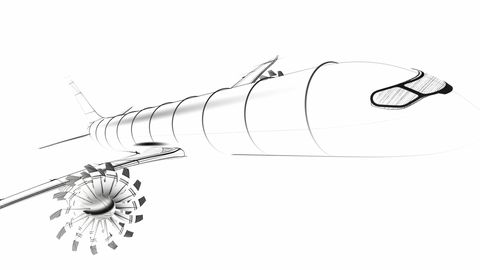Airspace Link – bringing the connected vision to reality

The mobile phone revolution which is happening on the ground, with more than seven billion smartphone users, is also taking place in the air. By 2027 Airbus expects almost 30,000 aircraft to be equipped with connectivity to support this exponentially growing digital appetite. But the trends encompass much more than smartphone usage. It also extends to the ‘Internet of Things’ (IoT) to connect, experience and control all the smart elements which we already take for granted in our homes – such as window blinds, fridges, coffee machines, air conditioning, home-entertainment systems, and so on. And similarly inside our cars. These consumer expectations are set to be mirrored inside our aircraft cabins as well.
Teams throughout Airbus have been hard at work defining, developing and demonstrating the ‘connected’ in-cabin technologies which we want to roll-out over the coming months and years.
“This roadmap first came to the fore thanks to Airbus “Connected Cabin Experience” mockup which we demonstrated for visitors at industry trade shows from 2018, and where we have won awards, such as Crystal Cabin,” recalls Ingo Wuggetzer, VP of Cabin Marketing at Airbus.
“Here Airbus not only demonstrated mockups on the ground, but our engineers also flight-tested real working technologies – including IoT for the first time – on our dedicated A350 Flight-Lab test aircraft, dubbed the ‘Airspace Explorer’.”
“Airbus also has produced its “Vision 2030” which focuses on the digital future of the cabin experience, and has presented this at various customer workshops to show a glimpse of what airlines can expect in the future. With such initiatives, Airbus is well prepared to turn this vision into reality,” says Ingo.
From concept to reality: “Airspace Link”
At the June 2022 Aircraft Interiors Expo in Hamburg Airbus is introducing the first elements of a real open connected ecosystem which is called ‘Airspace Link’.
“Airspace Link is a multi-layered and flexible approach, which starts with the Intelligent Core Management Platform – ICMP. This is the digital backbone covering the cabin management system as well as other layers,” explains André Schneider, VP of Cabin & Cargo Programme at Airbus.

He adds: “The next ‘brick’ of Airspace Link ecosystem are the IoT services which enable us to connect all the different elements within the cabin such as the overhead bins, the galleys, the seats, life vests.”
“We will also have what we call simply the ‘App Store’ that will host various applications for passengers as well as for airlines.”
“Last but not least, is the ability to connect the aircraft with the outside world. And here we are working on the connectivity elements, both air-to-ground and also satellite-based to have a flexible connectivity layer – so we can really move towards an end-to-end platform.
1. Airspace Link iCMP: intelligent Core Management Platform
The iCMP is SFE hardware provided by Airbus and is a replacement for our well known “Cabin Intercommunication Data System (CIDS). iCMP uses fibre-optic technology and provides the infrastructure for a digital smart platform enabling data access and management, content hosting, including IFE, and cabin management controls. iCMP full functionalities platform will be available on cross-programme starting with A320 family from 2026. In the meantime our “Head end Server Unit” (HeSU), provided by Kid Systeme, is available today as line fit and retrofit. The overall aim of the iCMP is to realise one platform connecting everything on board, which is open, flexible and efficient.
2. Airspace Link IoT Services: Smart data-based services
Based on smart cabin and cargo -enabled elements, Airspace Link also brings efficiencies for airline operations by aggregating relevant cabin data, combining those with different data sources (eg. CRM, ground-operations, supplier,) as input for big-data analysis. This enables IoT services for optimisation of ancillary revenues, passenger experience and operational efficiency.
Already tested in-flight on the Airspace Explorer Flight-Lab aircraft since 2019 are OLED welcome panels, digital galley, connected seats – Stelia business class seats and Recaro economy class seats – as well as elements of a “connected cargo” system.
3. Airspace Link App Store: apps for passengers and airlines
The Airspace Link App Store is a marketplace available to our airline customers. Apps can be offered from app developing partners, airline internal developers and Airbus Services. It allows Airbus, the airlines and or app developers to bring new functionality and content to the platform easily and efficiently.
Airspace Link ‘Wireless IFE’ is our first Airspace Link app available. This service is delivered to the airline by one of the three partners: Bluebox, Inflight Dublin and Display Interactive and is available today. Airspace Link Wireless IFE was launched with Titan Airways in 2019 and two early adopters: Jetstar Airways for its new A321neos, and with Condor for its A330neos starting this year.
“It will be a marketplace also for developers to come up with new ideas and we also see how fast the business is growing,” notes André. “So here we have the opportunity to open it up at aircraft level, enabling greater flexibility, also for airlines to integrate any kinds of apps in the future.”
4. Airspace Link “Connect”: The agnostic connectivity platform
To provide an end-to-end offer, we also need to connect the aircraft with the ground. To this end, and in the frame of the open ecosystem, we provide our customers with the flexibility to choose air-to-ground (ATG) or satcom solutions:
ATG for efficient broadband connectivity using radio-telephony transmission to be tailored for regional operations; and HBCplus – high-bandwidth satellite connectivity – which aims to become the one agnostic, SFE cross-program connectivity platform, capable of hosting multiple satcom providers.

In contrast to today’s provider-dependent connectivity end-to-end platforms, HBCplus offers airlines flexibility by utilising one standard Airbus hardware/software platform, including a standard low-profile antenna, radome and terminal. Entry into service of the Ka-band satcom solution is planned for 2024, with Ku-band planned to be introduced at a later stage.
Airbus launched HBCplus at the Aircraft Interiors Expo (AIX), together with Inmarsat Aviation as the first managed services provider (with more joining soon), and Safran Passenger Innovations (SPI) responsible for the terminal and antenna provision and integration.
With Airspace Link one can really apply the metaphor of a ‘flying smartphone’ because this is what we want to provide a connected aircraft ecosystem like a smartphone as easy to use for passengers and flexible for the airlines and our partners!
Ingo Wuggetzer, VP of Cabin Marketing at Airbus



